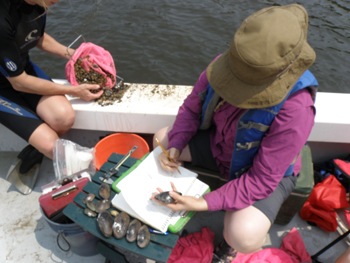Flexing Freshwater Mussels in the Delaware
Reposted from Healthy Waters for EPA’s Mid-Atlantic Region
By Matt Colip
It takes more than the brute strength of legislation to clean up America’s waterways. The complex process of aquatic ecosystem cleanup requires many tools, including one of nature’s most powerful muscles: her freshwater mussels.
That’s what the Partnership for the Delaware Estuary (PDE) – assisted by the Philadelphia Academy of Natural Sciences, and the U.S. Environmental Protection Agency’s (EPA) Scientific Dive Unit – set out to assess during a late summer freshwater mussel survey in a tidal section of the Delaware River near Philadelphia.
Freshwater mussels are bivalves similar to oysters and clams. But, unlike oysters and clams, freshwater mussels live in inland streams, and provide valuable benefits including strengthening streambeds by keeping soils in place and providing food and habitat needed by other animals and plants. As filter-feeders, mussels also clean the water in which they live by sucking water in and trapping solids such as dirt, algae and other pollutants, then releasing the clean filtered water back into the environment.
Being in the tidal area of the Delaware River as a scientific diver was an interesting experience. The water was not clear and flow rates were very high due to tidal fluctuation. In these conditions, I couldn’t help but think, “There’s no way there are mussels down here.” Despite my suspicions, when I reached the river bottom, sure enough, there were mussels everywhere, thriving and filtering the ambient water!
Ultimately, the survey, in addition to confirming the existence of an abundant freshwater mussel population in a very urbanized section of the Delaware River and providing valuable scientific data, gave me a newfound appreciation for what I used to only consider a tasty added protein to a pasta dish at a restaurant.*
For more information about freshwater mussels in the Delaware River, please visit the PDE’s website. Read more about EPA scientific diving at facebook.com/EPADivers.
About the Author: Matt Colip works in the region’s NPDES Enforcement Branch and focuses primarily on enforcing wastewater and stormwater regulations. Originally from Texas, Matt graduated from Franklin & Marshall College in Lancaster, Pa., with an interdisciplinary BA in Public Health and has a MS from Saint Joseph’s University that focused on environmental protection policy and management. In addition to SCUBA diving, Matt is an avid bicyclist and enjoys riding with friends and colleagues.
*EPA is not endorsing the consumption of oysters, clams and mussels in the wild. Please refer to the National Shellfish Sanitation Program guidelines associated with regulating the handling, processing and distribution of mussels prior to consumption.



 The silly season is finally over for my staff. No more traveling to small towns off the beaten path. No more chatting with folks at the grain elevator or eating chicken-fried steak smothered in gravy. No more coaxing the locals (of the four hoof variety) to shift their stance to the right or to the left. We won’t be back this way for another 4 years.
The silly season is finally over for my staff. No more traveling to small towns off the beaten path. No more chatting with folks at the grain elevator or eating chicken-fried steak smothered in gravy. No more coaxing the locals (of the four hoof variety) to shift their stance to the right or to the left. We won’t be back this way for another 4 years. A bit of parting wisdom for all of you future volunteers… I guarantee you getting a cow to change its position is tougher than getting a person. Just look at how distrustful these cows were of Shawn and Bray. They just wanted them to MOOOOOOOve on. Send all requests about the NRSA to
A bit of parting wisdom for all of you future volunteers… I guarantee you getting a cow to change its position is tougher than getting a person. Just look at how distrustful these cows were of Shawn and Bray. They just wanted them to MOOOOOOOve on. Send all requests about the NRSA to